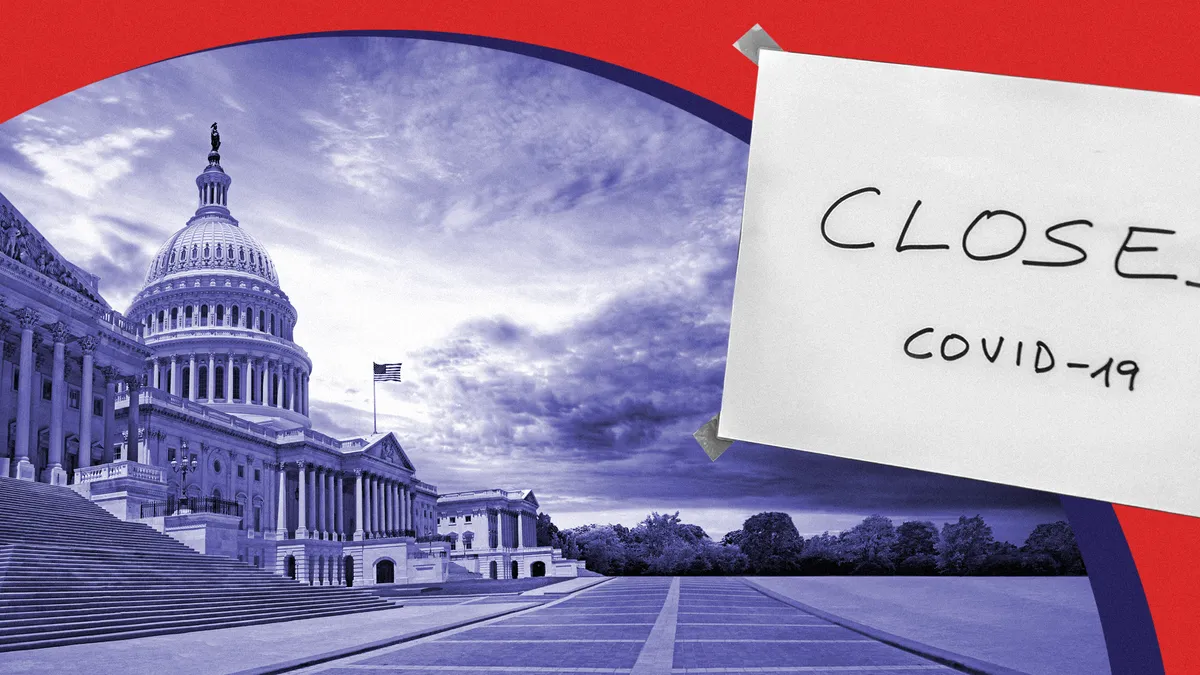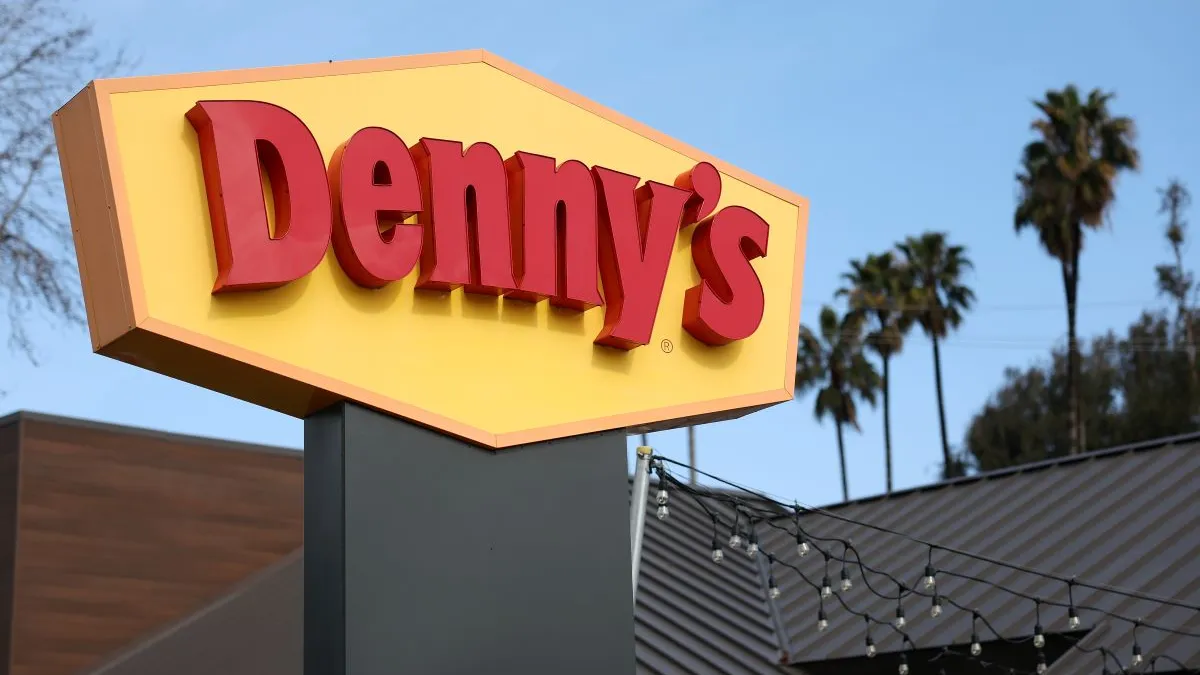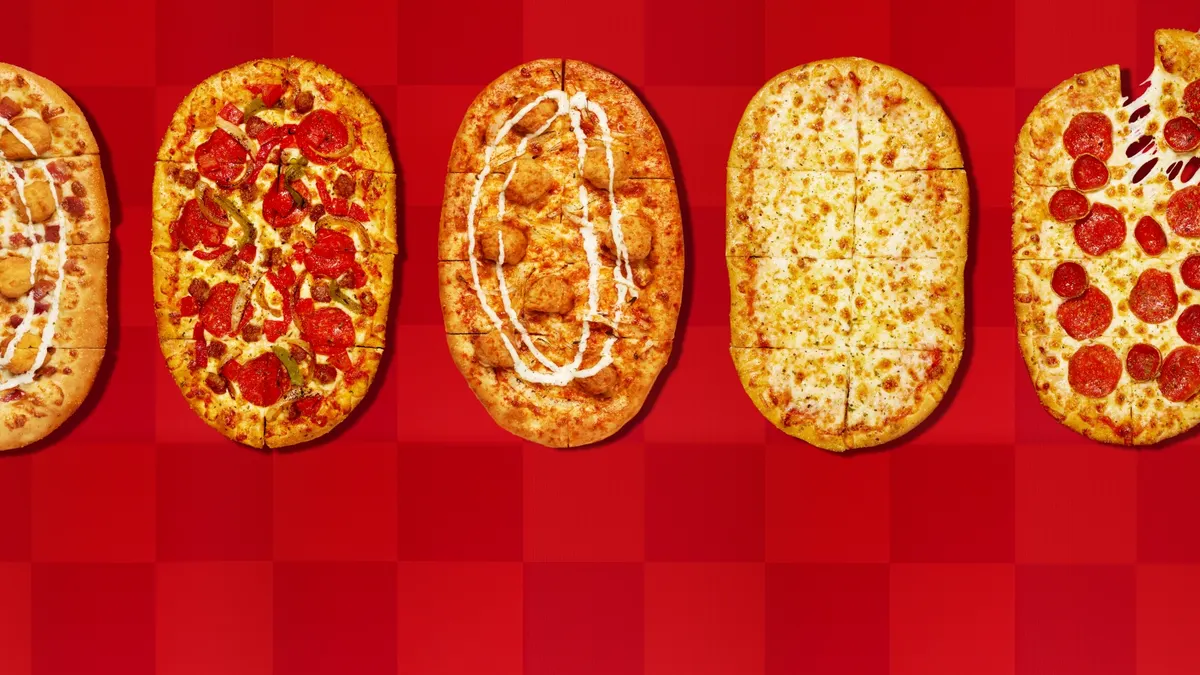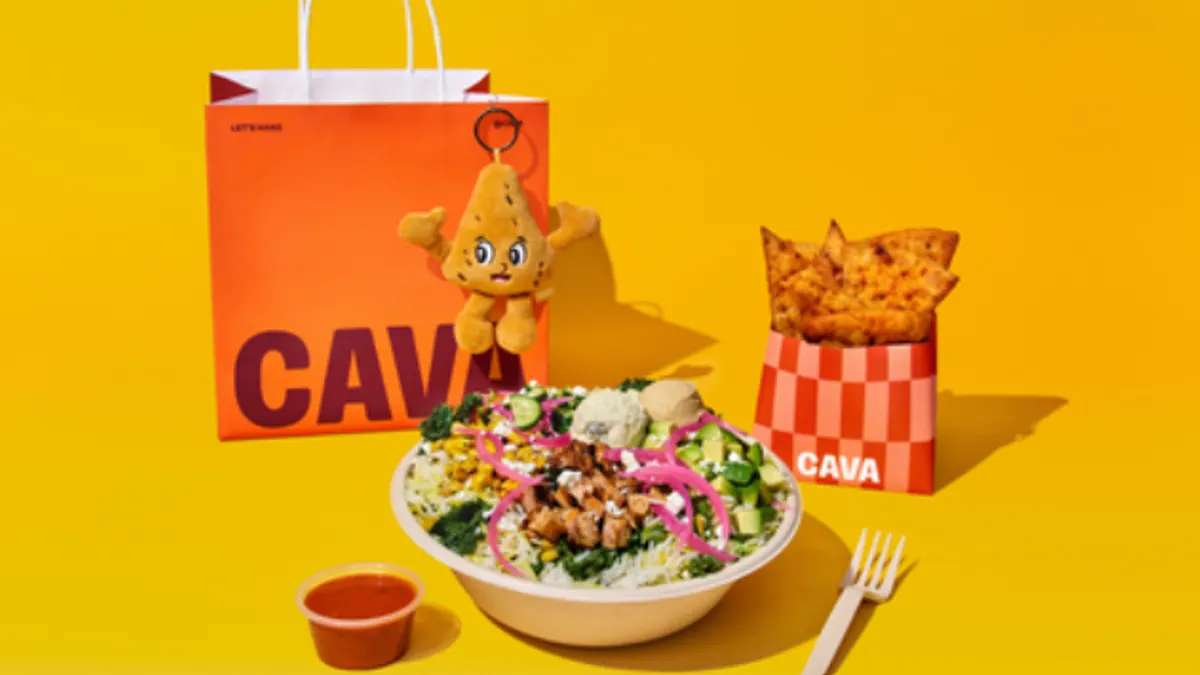This article is the fifth in a six-part series exploring how major restaurant cities were impacted by the pandemic. Future articles will be posted here.
Snapshot
- Restaurant closures to date: 124 as of March 19, according to the Restaurant Association of Metropolitan Washington. This is a 114% increase compared to closures between March 2019 and March 2020.
- Restaurant job losses to date: 28,900 — a 53.8% decline — between Feb. 2020 and Jan. 2021
- Restaurant sales losses to date: Sales declined 15.9% between Feb. 28, 2020 and March 14, 2021, according to Upserve by Lightspeed data.
"On March 16 I thought my career was over and that we were dead in the water. It was probably the most emotional time in my whole life. And from that day on at the start of the pandemic there wasn’t a whole lot to hold on to … there was not a whole lot of faith … in the federal government."

Jason Berry
Founder and principal, Knead Hospitality & Design
The Washington, D.C., restaurant market is an anomaly. Not quite a state, but more than a city, the District's restaurant revenue is pushed and pulled by the tides of political power. When there is a party change in the White House, the favorite bars and restaurants of Democrat or Republican staffers return to either feast or famine. Congress' summer recess drags downtown sales, but this dip is tempered by steady streams of tourists that descend on the National Mall.
District operators are accustomed to the unique rhythms of their market, but nothing could have prepared restaurateurs for the chaos of 2020. While other major restaurant towns struggled to survive pandemic restrictions, restaurants in Washington, D.C., also had to contend with government-mandated curfews amid widespread protests last summer. These came just days after restaurants were allowed to reopen outdoor dining on May 29.
"It was like a war zone," Knead Hospitality & Design founder and principal Jason Berry said. "It's not very sexy to sit on F Street in Penn Quarter when there's nobody outside and there's riots going on."
Then in January, restaurants had to adjust to the presence of thousands of National Guard members following the Capitol insurrection. As threats of violence continued to swirl in the wake of the siege, Washington, D.C., Mayor Muriel Bowser ordered restaurants to remain closed until two days after President Joe Biden's inauguration on Jan. 22 — dashing hopes of elevated restaurant sales. Inauguration is often one of the most lucrative times for local restaurants in a four-year cycle, Pizzeria Paradiso owner Ruth Gresser told The Washingtonian.
The District's Capitol Hill neighborhood was also segmented for months by layers of fencing and razor wire that snaked around the building's perimeter — trapping one historic restaurant inside the perimeter from mid-January until the end of March.
For Berry, these wild cards were exacerbated by frustration over how Washington, D.C., leadership and the federal government approached restaurant restrictions.
"There's no continuity in our country for how to respond to [the pandemic], which has obviously been a big disappointment I think for a lot of operators. The local government not knowing what to do, creating a rule, not wanting to change the rule because they don't want to look indecisive … instead of doing the right thing," Berry said. "It's good optics. But it's about bull—."
Despite this string of challenges, Washington, D.C.'s COVID-19 case rates are improving. In the 30 days between Feb. 23 and March 21, cumulative COVID-19 cases in the District only increased 8.6%, according to Washington, D.C.'s data. The city also recorded only one fatality on March 22 compared to three months prior, where it had seven deaths on Dec. 22.
It's impossible to know what percentage of District restaurant revenue, jobs and eateries could have been saved if certain restrictions — like alcohol service curfews and capacity restrictions — weren't enacted. One of the big questions that remains, however, is whether the District's dining restrictions helped quell local COVID-19 rates, and if they were worth the losses the local restaurant industry suffered
How changes to dining policy in Washington, D.C., affected COVID-19 rates
Bowser initially banned on-premise dining on March 16 last year, permitting delivery, takeout and drive-thru service only until outdoor dining was approved at the end of May. It took almost 30 days after this point before local operators were allowed to reopen their doors for indoor dining at 50% capacity.
Restaurant Dive calculated the percent increase of COVID-19 cases after each of Washington, D.C.'s restaurant policy changes, including the tightening and loosening of capacity caps, using data shared by the government of the District of Columbia.
The data shows that 30 days after the District's initial shut down of indoor dining, COVID-19 infections still increased 12,824%. This spike reflects the struggle shared by several major U.S. city governments to stem the spread of coronavirus cases in the first few weeks of the pandemic, when testing measures and safety protocols were still being developed.
When Bowser required District eateries to halt indoor dining for the second time just before Christmas — one of the most lucrative periods for the restaurant industry — cases rose 28% after a month.
A second interesting facet of the Bowser administration's COVID-19 data centers on recorded outbreaks at restaurants compared to other businesses and highly trafficked spaces. Between July 31, 2020 and March 4, 2021, for example, D.C. Health reported 32 outbreaks at restaurants and bars compared to 18 outbreaks at office buildings and 26 at K-12 schools.
In the month of December, before indoor dining shuttered on Dec. 23, there were seven outbreaks recorded at eateries. There were also seven outbreaks between Jan. 22 — when District restaurants reopened at 25% capacity — and Feb. 26.
Though this data is interesting, it can't paint a full picture of how local COVID-19 cases correlated to restaurant restrictions. Factors like travel, personal gatherings and the influx of visitors for the large protests over the summer could have also impacted COVID-19 spread. This gray area makes it challenging to gauge whether restaurant capacity restrictions can actually slow a population's contraction of coronavirus, which has led to disparate approaches to dining guidance by local governments across the country.
The need for financial support
As restrictions deeply narrowed how restaurants could bring in revenue, Washington, D.C., released several initiatives to try to alleviate this financial burden.
Restaurant-targeted support issued by city or state
- The D.C. Council passed a bill in April 2020 banning evictions and prohibited landlords from raising rent and charging late fees as long as the mayor's public health emergency order remains in effect. On Dec. 16, a D.C. Superior Court judge, however, ruled the moratorium on filing new eviction cases violates the constitutional rights of landlords.
- Washington, D.C., launched its Streatery Program on May 29. The outdoor dining program is still available to restaurants that are not already permitted for outdoor space or want to expand their existing outdoor space. Restaurants can apply to use sidewalks, alleys, parking lanes and travel lanes for seating.
- On Sept. 1, the District rolled out a $4 million winterization grant program for restaurants and non-food retail businesses. The program offered $6,000 to businesses with active sidewalk cafe permits, including temporary "streatery" permits, or private outdoor spaces. Grants could be put toward expenses including tents, heaters, propane, furniture, advertising and operational costs of outdoor space. All independent and locally owned businesses could apply, but non-local franchises were ineligible.
- The $100 million Bridge Fund to support hospitality and entertainment businesses, which allocated $35 million for area restaurants, opened on Nov. 18. Up to 700 restaurants could have received grants of $10,000 to $50,000 each.
"There's a cost each time you have to open your indoor dining and there's a cost each time you close it. ...These grants in D.C., it sounds like a big amount of money, but we're limited to $35,000 per restaurant — that's a drop in the bucket. It helps, but it doesn't answer the issue."

Danny Lledo
Executive chef, Xiquet
Up Close: Knead Hospitality ‘hellbent’ on restaurant survival after fears of career-ending pandemic
When Washington, D.C., ordered restaurants to close their dining rooms on March 16, Berry considered it a death knell.
"I thought my career was over and that we were dead in the water," he said. "It was probably the most emotional time in my whole life. And from that day on at the start of the pandemic there wasn’t a whole lot to hold on to … there was not a whole lot of faith … in the federal government."
Berry's restaurant group, Knead Hospitality, was operating four restaurants at the start of the pandemic. One, a sit-down Southern restaurant called Succotash, is located in National Harbor, Maryland, and so hasn’t been subjected to the District's restrictions, which have been more stringent than policies rolled out by neighboring Virginia and Maryland. But Berry's second Succotash restaurant is situated less than a mile from the White House.
"If you look at the neighborhoods in D.C., I think Penn Quarter is probably the most impacted due to the loss of the [Capital One] arena and with everyone working from home, there's no real business," Berry said. "Summer is traditionally a fairly slow time anyway in Penn Quarter. … Tourism is good, but Congress is out and there's not a lot going on."
Berry tried to operate the D.C. Succotash location for takeout and delivery for the first few weeks of restaurant closures, but there was virtually no business. Knead Hospitality temporarily closed the location, which is still shuttered. Berry came to an agreement with the location's landlord to open at the end of August, when vaccinations will hopefully be more widespread and commuters could begin to return to downtown.
"It didn't make sense to us to try to reopen [Succotash] this spring before going into a slower summer, with the pandemic as an extra kick in the teeth," Berry said.
Knead Hospitality's remaining locations — Mexican restaurant Mi Vida and new American restaurant The Grill, both located in The Wharf district of Washington, D.C.'s waterfront — have been open since June of last year after temporarily closing.
Mi Vida experienced strong takeout and delivery demand from the outset of dining room closures, which Berry attributes to Mexican food's ability to make "people feel really good when they're depressed."
The Grill, however, had opened in mid-February, just before the District's lockdown.
"That was the fastest 'open and close' in the history of my career," Berry said.
The wood-fired concept operated as a butchery and grocery during the early days of the pandemic, which brought in decent traffic because the closest grocery store to residences at The Wharf are a half mile away, Berry said.
"Thousands of residents at The Wharf had nowhere to go to get groceries, and you couldn't get anything from Amazon Fresh because they were so quick to be sold out," he said.
Still, these early sales were just a fraction of Knead Hospitality's 2019 numbers.
"Last year we picked ourselves up by our bootstraps, and said, 'Okay, do we want to survive, or not? What are we going to do?'... We did takeout and delivery at our restaurant like everybody else did. We had to furlough all 305 employees," Berry said.
Knead initially rehired a skeleton team of chefs, sous chefs and managers to run the restaurants still in operation, but expenses were still a major pressure.
"We rob Peter to pay Paul because we were paying invoices from three days ago with today’s revenue — that's how we run our restaurants … you don’t keep all of your cash on hand," Berry said.
The District serves support and stress for local operators
For most of Knead's restaurants, Berry received Paycheck Protection Program loans, as well as grants from Washington, D.C.'s $100 million Bridge Fund.
Knead Hospitality didn't benefit from the District's Streatery program, which allows restaurants to expand outdoor seating into sidewalks, parking lots and streets, because its concepts at The Wharf were able to expand their patio space through their landlord. It also didn't pursue the opportunity for Succotash in Penn Quarter because there was a dearth of foot traffic.
Berry feels that Washington, D.C., has handled pandemic response better than most local governments, but said the impact on restaurants "was still a disaster and continues to be a disaster."
He feels that the District’s restrictions were more reflective of the government's attempt to keep up appearances of safety and productivity than evidence-based efforts to keep the virus at bay.
"These restrictions aren't going to have much benefit and they’re only going to hurt restaurants further," Berry said. "It really depends on what restriction and what day and how the wind blows. The mayor is more concerned about indoor dining operations than she is about the safety of the citizens."
Danny Lledo, the executive chef of Xiquet, a fine dining restaurant that specializes in Valencian cuisine in Glover Park, is also frustrated by how the Washington, D.C., government approached dining restrictions compared to guidance on in-home gatherings.
"I can’t tell you how many [takeout] orders I've had for parties of six or more. ... I did a paella for 12 people, [and] I couldn't get the paella pan back for a month because they all had COVID-19," Lledo said.
Lledo argues that during periods of indoor dining closures, the government was essentially encouraging the spread of coronavirus because District residents sought out social activities at friends' homes.
"We can't have a party of six or more, and I think that's good. I think it's appropriate, or we should do one party per household," Lledo said.
And while he thinks that Washington, D.C., leadership made a genuine effort to support restaurants financially through these closures, Lledo feels the local government doesn't understand the toll that dining room shutdowns take.
"There's a cost each time you have to open your indoor dining and there's a cost each time you close it. You lose product. You can lose personnel. You have to hire new personnel, you have to train them. That cost is not always visible," he said. "These grants in D.C., it sounds like a big amount of money, but we're limited to $35,000 per restaurant — that's a drop in the bucket. It helps, but it doesn’t answer the issue."
Berry said he and local restaurants found shifts in capacity restrictions and caps on alcohol service particularly frustrating. At 25% capacity, Mi Vida can accommodate 100 diners, for example, but because of table spacing restrictions, there isn't a significant difference in how many consumers the restaurant can seat when 50% capacity is allowed. Still, the restrictions on bar service were more impactful to sales, Berry said.
"We literally ha[d] to pull it off the table [at 10 p.m.], and go to tables at 9:50 p.m. and say you can take it to-go if you want but I could have the Alcohol Board in my restaurant and walking around, and I don’t want to get fined over this. And that creates less traffic, and I think that [was] more hurtful to restaurants than any sort of occupancy issue," he said.
Looking to the future
The District's restaurant segment has faced more extremes than most restaurant markets over the past year, with operators struggling to maintain cash flow amid surging case rates, government-mandated curfews during downtown protests and extended National Guard presence and road closures following the Capitol insurrection.
These chaotic events are mostly in the rearview mirror, but roughly 2,300 Guard members will remain in the area through May due to possible threats of violence. RAMW also expects at least 25% of District restaurants to close permanently as a result of the pandemic, the association said via email.
"Unfortunately D.C. had the insurrection and the inauguration killed the city in terms of business… [it] basically shut down the city for two weeks. Who's paying for those employees? The customers aren't. And now that we've reopened it’s not like every restaurant has lines waiting across the board," Lledo said.
Still, spring has arrived, the razor wire surrounding the Capitol has been removed, and blossoming trees and warmer weather are giving operators hope for a return to normalcy.
"I think sales are looking up, the momentum is fantastic. We're not where we were in 2019 compared to this week and last week but we're a hell of a lot closer than we have been," Berry said. "The weather is starting to really turn, and there is a complete correlation between weather and traffic. People want to be outside, they want to be in the sunshine, they know it's safe, they know it’s healthy, so patios are just booming."
Since Monday, local restaurants have been allowed to extend their alcohol service to midnight, and Bowser will reassess capacity restrictions next month. Restaurant employees have also been eligible for COVID-19 vaccination since March 15, which could make some restaurant talent feel more comfortable serving guests. The District is also exploring making the Streatery program permanent, with a recent District Department of Transportation survey finding that 87% of program participants reported the initiative increased their revenue and 89% support a permanent Streatery program once the pandemic ends.
How Washington, D.C.'s restaurant foot traffic shifted a year after the pandemic
But challenges still abound for operators, especially when it comes to hiring, Berry said, which he attributes to unemployment benefits.
"When [workers] have this unemployment bonus of $300 per week on top of the state unemployment, making between $700 and $1,000 a week, why go to work?" Berry said. "I think there is a huge disincentive to go back to work."
Because of this reduced labor pool, local restaurants are struggling to find employees, Berry said. Three major restaurants are opening within five days of the debut of Knead’s upcoming restaurant, The Gatsby, which opens in two weeks.
"We're all competing for the same talent," he said.
Knead Hospitality has been offering hiring bonuses to entice new workers, which has helped attract applicants, but these candidates are less experienced than the restaurant talent the group normally hires. As a result, the restaurant group has to implement more training than usual to ensure its hospitality standards are met.
Berry believes some of the drop-off in restaurant labor is driven by fear of contracting COVID-19, but argues the risk is low and the financial opportunity — some of his best servers make $70,000 to $80,000 annually — is better in the restaurant than through unemployment benefits.
"People are afraid to work even though there hasn't been a single transmission between a guest and our staff since we reopened [in June]," Berry said. "Yeah, you're going to have to work for it. You're going to wear a mask. You're going to be okay."
Though he is confident diner demand for large celebrations, events and just a sense of normalcy will help the industry bounce back, Berry will change some of Knead Hospitality's strategy going forward to insulate the business against future pandemics.
"At least for me, [changes] are going to be do you have pandemic-related clauses in your lease that nobody had beforehand. … If something like this were to happen again, which everyone says is possible, then we need to make sure that we're not at a landlord's whim on whether rent is due or not," Berry said. "The terminology that I’ve used with my new landlords and existing landlords is 'there needs to be shared pain.' I'm willing to be hurting, but I’m not willing to be hurting alone."
Real estate that can accommodate outdoor dining will also be a major consideration, Berry said.
"Restaurant 101 is location, location, location. The only restaurant of mine that didn’t reopen is the one that's mid-block without a patio. It's reopening, but it hasn't reopened yet, because it happened to be in a neighborhood where there was no patio, and we can’t really service a patio because of [the building]’s historic storefront, so we’re kind of screwed," he said.
This dynamic could make it difficult for young chefs and restaurateurs to rent locations that are positioned well to survive future pandemic disruption, Berry said, which could have a negative impact on restaurant culture.
"You could get a space at a lower price than a space on the water, but guess which one is going to have more traffic when shit hits the fan?" Berry said. "People want to sit outside. People want to sit on the water. There's a perception that being on a waterfront is healthier than being on the street. And it probably is, you have fresher air."
But real estate left behind by restaurants who didn’t survive the pandemic’s first year also offers opportunity for new experimentation by restaurant talent.
"I would never wish a correction in the industry like this, but 25% of the restaurants in our industry fail, so the operators that were lost during COVID-19 — a good percentage of those were probably not operating well to begin with ... and were probably going to close at some point soon anyway," Berry said.
Berry credits his waterfront locations as part of the reason Knead Hospitality actually turned a profit over the past 12 months, rather than just breaking even. Still, overall revenue last year was about half of 2019's total, he said.
He hopes that pent-up consumer demand will buoy this upward trend. Knead Hospitality is launching additional new restaurants soon as well. Later this spring and summer, the restaurant group will also open a French restaurant called Bistro Du Jour at The Wharf, a Mexican restaurant called Mi Casa in Dupont Circle, a bakery called Mah-Ze Dahr at National Landing, near Amazon's local headquarters, and restaurant concepts within Swingers, a trendy mini golf establishment coming to Dupont Circle.
"We are social animals. We have to be together in order to live. ... I'm pretty hellbent on that happening in the near future," he said. "I'm very optimistic, especially compared to 12 months ago when I thought my career was over."
Correction: A previous version of this article incorrectly stated how many diners Mi Vita can seat at 25% capacity.





















